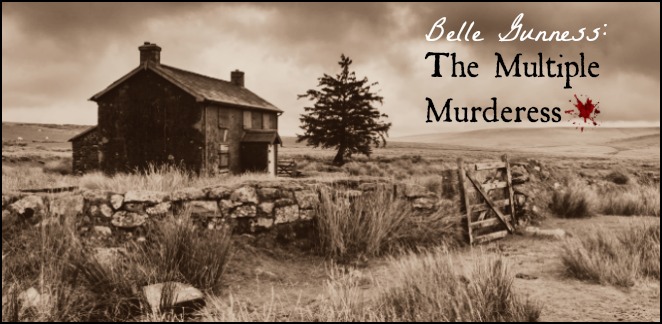
A steady stream of gentleman callers showed up at Belle Gunness’s farmhouse in LaPorte, Indiana during the first decade of the 20th century. Bearing flowers, shy grins, and—most important to Gunness—their life savings, the suitors came in response to a matrimonial ad that Gunness had placed in several Midwestern newspapers. The two-time widow was seeking a husband, a man of means whose expertise and money would help Gunness turn her thriving farm into an even more lucrative business.
When Gunness opened her door to the hopeful knocks that fell upon it, her suitors might have felt a jolt of surprise, as the woman who met their eyes wasn’t quite as “comely” as her advertisements had promised. Gunness was a tall, stocky woman whose drab clothing and schoolmarm-ish hair were fitting counterparts to her dour expression, Still, it was the early 20th century, a time when marriage was sometimes a practical matter rather than a romantic pursuit. Union with Gunness would mean a financial windfall for the lucky man who wed her, so suitors overlooked Belle’s aesthetic shortcomings and accepted her invitations to dinner. As the men stepped inside their prospective fiancée’s home, they remained blissfully unaware that they would never leave the property again.
Belle Gunness used her skills of persuasion to become one of the most prolific serial killers in American history. It’s suspected that she robbed and murdered as many as 40 men, whom she invited into her home under the guise of seeking a husband. Gunness is also suspected of killing her five children, two husbands, and various other people who stood in the way of her murderous plans. The combined horror of these deaths is chilling enough, but what’s really unsettling is the fact that no one knows exactly what happened to Gunness after her crimes were discovered. Frightening though the thought may be, Gunness might have escaped punishment and lived the rest of her life in anonymity, perhaps free to pursue her homicidal hobby among a new crop of unsuspecting bachelors.
Born Brynhild Paulsdatter Størseth in Norway in 1859, Gunness immigrated to the United States in 1881. With a new home came a new name—Belle. In 1884, Belle married Mads Sorenson, with whom she had four children. It was at this point when the specter of suspicious death made its way into Belle’s life. Two of her children, Caroline and Axel, died in infancy from colitis (a disease whose symptoms mirror the effects of poisoning). Not long after that, in 1900, Mads Sorenson perished from what doctors said was a heart ailment. Sorenson’s relatives insisted that Belle had played a role in Mads’ death, but records don’t indicate whether authorities investigated those claims. In any event, the $8,500 in insurance money that Belle received following her husband’s demise was a source of consolation in the face of her in-laws’ suspicions. It was with this money that Belle purchased the farm where, in the coming years, her ill-fated suitors would spend their final moments.
Shortly after moving to LaPorte with her remaining children, Myrtle and Lucy, Belle married her second husband, a widower named Peter Gunness, in April 1902. Within a week of the nuptials, Peter’s infant daughter was dead, having succumbed to a mystery ailment while in the care of her new stepmother. By December 1902, Peter himself had died, the victim of an injury he sustained when, according to Belle, a sausage grinder fell on his head. Once again, Belle received a sizable insurance settlement and, despite whispers from suspicious neighbors, carried on with the business of running her farm as a single mother.
Gunness was a savvy and formidable woman, and eventually decided that a third marriage—or at least the prospect of one—would fill her coffers even fuller. She created her matrimonial advertisement and entertained a parade of eligible bachelors, who saw the ad as their ticket to a stable life with home-cooked meals, comfortable living arrangements, and a thriving agricultural business. As Gunness requested, the men often arrived with their life savings, prepared to merge their fortunes with those of their new sweetheart. Yet despite her many romances, Gunness never made it to the altar. In fact, several of her suitors simply disappeared, though Gunness was able to keep the strange goings-on at her farm a secret from her neighbors in LaPorte.
The first inkling that anything was wrong came in the early morning of April 28, 1908, when Gunness’s handyman, Joe Maxson, woke from a sound sleep in his second-floor bedroom to discover that the Gunness farmhouse was on fire. Maxson rushed into town for help, but by the time rescuers arrived, the house was too far gone to save. After the ashes cooled, investigators discovered the bodies of four people in the charred remains. Three of those bodies belonged to Gunness’s children (Myrtle, Lucy, and son Phillip, whose father was Peter Gunness), while the fourth was that of a headless woman whose identity couldn’t be verified. Despite the questions remaining about the unknown victim, the fire seemed an open-and-shut case of arson, with the prime suspect being Ray Lamphere, Gunness’s former handyman, whom she had recently fired. When a young boy stated that he had seen Lamphere run away from the burning farm, the handyman was arrested and charged with arson and murder.
From there, the situation at Gunness’s farm became even more grotesque. Asle Helgelien, the brother of Andrew Helgelien, one of Gunness’s suitors, showed up in LaPorte shortly after the fire and stated his belief that Andrew had met a grisly end at Gunness’s hand. Andrew Helgelien had told his brother about his plans to visit Gunness, but had never returned home—nor contacted Asle—after his stay at the Gunness farm. This fact, coupled with current handyman Maxson’s revelation that Gunness had instructed him to bring wheelbarrows of dirt into the farm’s hog pen—an area now pocked with strange depressions—prompted the men of LaPorte to grab their shovels and start digging.
What they found was astonishing: the bodies of several men (including Andrew Helgelien), one young woman (believed to be Gunness’s adopted daughter, Jennie Olson), and two children. The bodies were in such disarray that authorities couldn’t determine how many they’d actually found; estimates hovered at around twelve victims whose bones lay buried in the Gunness hog yard. As word of the gruesome discovery spread, family members of other missing men contacted authorities to report that their own loved ones had made plans to visit Gunness and had never been heard from again. The list of potential victims climbed until, according to some estimates, it numbered more than forty.
A few weeks after the fire, Lamphere’s trial began. Though the bodies of Gunness’s children were easily identified, uncertainty remained regarding whether the headless body found in Gunness’s home actually belonged to the murderess. Some LaPorte residents who viewed the remains said that the body was too small to have belonged to Gunness. Likewise, though Gunness’s dentist testified that bridgework found on the property belonged to her, tests indicated that the false teeth could not have survived a fire as intense as the one that consumed the Gunness farmhouse. This led to accusations that the bridgework had been planted, likely by the man who found it. Perhaps the biggest argument for Gunness’s demise in the fire was the fact that she hadn’t been seen since it occurred.
Ultimately, Lamphere was convicted of arson but not of murder, and was sentenced to 20 years in prison. He died of tuberculosis after serving only one year of his sentence. A clergyman who spoke to Lamphere before his death claimed that Lamphere had confessed to helping Gunness bury some of her victims, whom she had killed either by poisoning them or by splitting their heads with a meat chopper. According to the clergyman’s version of Lamphere’s testimony, Gunness disposed of the bodies by burying them around the farm or, on occasion, feeding them to her hogs. Lamphere answered the key question—was the headless body that of Gunness?—with a resounding “no.” He claimed, said the clergyman, that the body belonged to a woman whom Gunness had lured into the house and killed for the purpose of staging Gunness’s death. Gunness herself, Lamphere said, had set the fire with Lamphere’s help and had fled LaPorte alive, well, and ready to reestablish herself in a different part of the country.
Gunness’s fate has never been proven. Was she killed in the fire, or had she escaped? The 1931 arrest of a California woman named Esther Carlson, who was accused of poisoning a man, generated support for the latter hypothesis, as some of Gunness’s friends believed that photos of Carlson bore a striking resemblance to Gunness. Students of the case remain divided in their beliefs as to whether Gunness perished in the house fire, or made the greatest escape of her life. Regardless, it can’t be denied that Belle Gunness was an evil, conscience-less woman who, far from evincing a personality evocative of the French meaning of her name, nurtured a nasty side that spelled death for the men who wanted to make her their wife.










